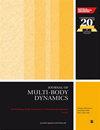在模型预测控制算法中引入基于反馈的振动能量汇的运动柔性系统跟踪控制
IF 1.9
4区 工程技术
Q3 ENGINEERING, MECHANICAL
Proceedings of the Institution of Mechanical Engineers Part K-Journal of Multi-Body Dynamics
Pub Date : 2022-06-22
DOI:10.1177/14644193221102105
引用次数: 4
摘要
针对具有欧拉-伯努利振动梁的移动多变量振动结构的非线性跟踪控制问题,提出了一种新的方法。该控制方案包括获取多变量连续力学系统的弯曲运动和刚性运动之间的相互作用,并在域和带宽上限制作动器的力。为此,选择边界控制输入,优先考虑两个任务,满足执行器限制并获得最小可能的跟踪误差。前者作为模型预测控制(MPC)方案的硬约束,后者作为软约束。调整控制方案,当超过执行器限制时,放松软约束以保持稳定性。为了提供平滑跟踪,在获取控制律时采用反馈振动能量汇(FVES)方法对欧拉-伯努利横向振动进行衰减。因此,在不使用被动或传统的主动阻尼器的情况下,操纵致动器使柔性梁的总振动能量受到阻尼。通过有限元仿真验证了该方法的准确性。本文章由计算机程序翻译,如有差异,请以英文原文为准。
Tracking control of moving flexible system by incorporation of feedback-based vibrational energy sink in model predictive control algorithm
This paper proposes a new approach towards the nonlinear problem of tracking control for mobile multivariable vibrational structure featuring an Euler-Bernoulli vibrational beam. The control scheme involves obtaining interactions between flexural and rigid motions of the multivariable continuum mechanics system with actuator force limitation both regarding domain and frequency bandwidth. To this end, the boundary control inputs are selected prioritizing two tasks, satisfying actuator limitations and obtaining minimum possible tracking error. The former is employed as hard constraint in model predictive control (MPC) scheme while the latter is considered as soft constraint. The control scheme is adjusted such that when actuator limits are exceeded, the soft constraints are relaxed to maintain stability. In order to provide smooth tracking, Euler-Bernoulli transverse vibration is attenuated by incorporating Feedback Vibrational Energy Sink (FVES) method in obtaining control law. Hence, actuators are manipulated such that total vibrational energy of flexible beam is damped without using passive or conventional active dampers. The accuracy of the proposed method has been verified via FEA-based simulations.
求助全文
通过发布文献求助,成功后即可免费获取论文全文。
去求助
来源期刊

CiteScore
4.10
自引率
11.10%
发文量
38
审稿时长
>12 weeks
期刊介绍:
The Journal of Multi-body Dynamics is a multi-disciplinary forum covering all aspects of mechanical design and dynamic analysis of multi-body systems. It is essential reading for academic and industrial research and development departments active in the mechanical design, monitoring and dynamic analysis of multi-body systems.
 求助内容:
求助内容: 应助结果提醒方式:
应助结果提醒方式:


